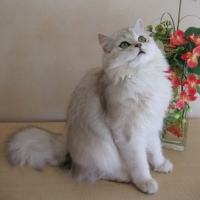

The breed of longhaired cat the originated in Great Britain and is closely related to the British Shorthair is called the British Longhair. It came about through crossing with the Persian and other longhaired cat breeds and is now recognized by many of the major cat registries.
History
The history of the breed is a little uncertain but is believed to have come from the crossing of British Shorthairs with longhaired imported breeds such as the Persian and the Turkish Angora. The Shorthair is one of the oldest British breeds of cat, with its ancestry dating back to Roman times and was the protector of farms and ships for many generations due to its hunting skills.
In the late 19th and early 20th century, the British Longhair was simply thought to be a type of Persian but when the shorthaired version, the Exotic Shorthair, came along in the late 20th century, it was realized that the British Longhair was a breed in its own right. The Governing Council of the Cat Fancy (GCCF) in the UK declared that only 3rd generation of a Persian/Shorthair cross could be exhibited as a British Longhair and the breed was given championship status in 1979. It was accepted for championship status by TICA in 2009.
Appearance
The coat of the British Longhair is lustrous and comes in a wide range of colors and patterns, just as the British Shorthair does. These can include black, white, red, cream, blue, chocolate, lilac, fawn and cinnamon and patterns such as self, tabby, tortoiseshell, bicolor and color point.
In physique, they are stout with a round head, bright, rounded eyes and short ears. They have short and strong legs and a plush and thick tail. Their deep chest adds to the overall compact appearance of the cat, typically of medium size.
Personality
Both British Longhair and Shorthair breeds are similar in personality and are friendly and affectionate cats that love attention but are undemanding. The males tend to be happy-go-lucky while the females are a little more reserved and both genders make for devoted companions. They do have their play sessions when they run around madly and play but are generally more reserved and aren't keen on being picked up and carried around. They will live well with children and dogs and are happy to spend time on their own while their owners are out at work.
Health
The Longhair nature of the breed means they do require some grooming on a daily basis to ensure their coats remain without tangles. It is also a good idea to learn them from being kittens to be regularly bathed to help condition their coat.
Because these cats aren't the most active, they can be prone to gaining weight and becoming obese so monitoring their food intake is a good idea. They need to be solid in body without a fat on them and if they are beginning to get overweight, encouraging extra exercise is a good way to ease the problem. Prompting them to run around with toys or other methods of play are a good way to get them to be active, to spend time with them and to stop them gaining unnecessary weight.
Copyright © 2005-2016 Pet Information All Rights Reserved
Contact us: www162date@outlook.com